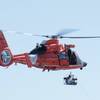Feature: Innovative Coastal Trader
By David Tinsley, technical editor
An advance in hydrodynamic design has been endorsed by Norwegian energy group Statoil, as the prospective charterer of an innovative newbuild intended for coastwise distribution of oil products. The 4,200-dwt vessel contracted by Bergen Tankers will employ a diesel mechanical propulsion layout based on twin azimuth thrusters incorporating 'pulling' propellers. The project represents the first application of the Norwegian-developed Azipull system in the tanker market, and champions the principle of redundancy, conferred through the use of two, independent propulsion lines.
The engineering and propulsion arrangements selected for the 90m coastal tanker have been shaped by exacting requirements as to maneuverability, design efficiency, safety and transport service dependability. The order signals the commercial breakthrough for the NVC-Design concept developed by Nordvestconsult, part of Rolls-Royce Marine, in response to the evolving needs of products carriers and chemical tankers in the 3,000 to 20,000-dwt range. Ulstein Aquamaster Azipull propulsion units, also emanating from the Rolls-Royce stable, are central to the NVC-Design philosophy.
The seminal class of small, distributive trader booked by Bergen Tankers will combine Norwegian technology with keenly competitive Turkish production, since the newbuild contract has been awarded to RMK Marine, on Tuzla Bay. RMK has a growing reputation in higher quality, specialized areas of the market, including mega-yacht construction. Due for delivery in September 2005, the double-hulled vessel will work along the Norwegian coast out of Statoil refineries, offering a 10-tank compartmentalization for a total 5,200-cu. m. cargo volume. It will be propelled by two AZP085 thrusters, fitted in each case at with a controllable pitch propeller at the forward end, and driven by medium-speed diesels of some 1,400-kW apiece.
The specification calls for a service speed of 13.3-knots, on the basis of 90-percent maximum continuous output and 15-percent sea margin, and additionally looks to a 70-percent full speed capability with just one of the two propulsors and one of the main engines in operation.
The Azipull propulsor is a purely mechanical device, which dispenses with the need for a separate gearbox since gear reduction is built into the unit. In the coastal tanker application, a generator will be interposed on the shaft between each main engine and thruster. The shaft generators will thereby cover the vessel's at-sea electrical power load, supplemented by a 500-kW, electrically-driven bow thruster when maneuvering. The arrangements enable one engine to be shut down in port, and allow the other unit to be declutched from its thruster, driving its shaft generator to power the cargo pumps and meet the vessel's service load.
The system offers full redundancy in both propulsive and electrical power supply, and also permits maintenance of one engine to be conducted while berthed at a terminal, with propulsion still available from the other 'side' of the system should vessel be required to rapidly leave the berth in an emergency.
The Rolls-Royce Nordvestconsult designers claim that the compact nature of the Azipull-based installation has yielded a 5-7% increase in cargo tank volume in relation to other propulsion solutions within the given hull envelope. In developing the hull form, the Aalesund-based consultancy had to ensure that the ship would have good course-keeping stability. It contends that hulls with length-to-beam ratios desirable for low first cost and high earning capacity have, in the past, demonstrated poor course stability when propelled by azimuth thrusters, needing large steering corrections, resulting in heavier fuel consumption. Azipull thrusters, with their hydrodynamically-optimized underwater units, provide substantial rudder area, offering improved performance as regards directional stability. Even so, a program of computational design and model testing was undertaken to ensure that the tanker would offer course stability in excess of the IMO zig-zag test requirements.
The deal for the Azipull azimuthing pulling propellers follows the service debut for the system on a double-ended fjord ferry, and subsequent contracts in the offshore support vessel market.












